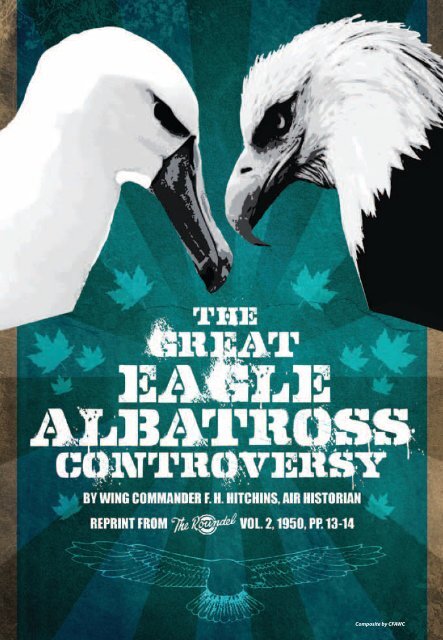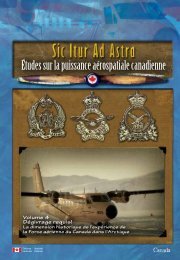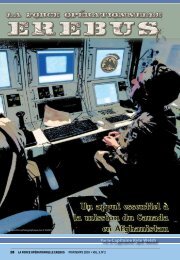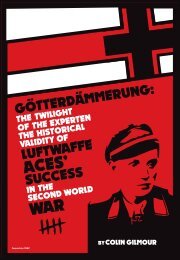By Lieutenant Colonel Roy C. Bacot (USAF)
By Lieutenant Colonel Roy C. Bacot (USAF)
By Lieutenant Colonel Roy C. Bacot (USAF)
You also want an ePaper? Increase the reach of your titles
YUMPU automatically turns print PDFs into web optimized ePapers that Google loves.
<strong>By</strong> <strong>Lieutenant</strong> <strong>Colonel</strong> <strong>Roy</strong> C. <strong>Bacot</strong> (<strong>USAF</strong>)<br />
Composite by CFAWC
Time was, say the oldsters, when<br />
a simple statement in a Service<br />
Mess about the bird that appears on<br />
RCAF [<strong>Roy</strong>al Canadian Air Force] buttons<br />
and badges was sure to start an argument that<br />
would last far into the night.<br />
This once-burning issue about the bird’s<br />
true identity has all but flickered out, and<br />
(it is hoped) new members<br />
of the Force are correctly<br />
“indoctrinated” that the<br />
bird is an eagle. Mention<br />
that to a veteran wearing<br />
First World War ribbons,<br />
however, and you run a<br />
risk of becoming involved.<br />
If he flew in the Old<br />
<strong>Roy</strong>al Naval Air Service<br />
[RNAS] (and three of<br />
our four Chiefs of the Air<br />
Staff did), a gleam will<br />
come into his eye and he<br />
will begin convincing you.<br />
<strong>By</strong> the third round you<br />
will find yourself tactfully<br />
agreeing that it isn’t an<br />
eagle at all, but—as any<br />
clot can plainly see—<br />
an albatross.<br />
Actually the controversy was settled—<br />
officially—long before it even began, and, for<br />
the benefit of those who have endured, or have<br />
yet to face, the argument, here are the facts.<br />
It all started in the summer of 1914 when<br />
the Board of Admiralty took it upon itself, in<br />
defiance of Cabinet orders issued two years<br />
earlier, to rename the Naval Wing of the <strong>Roy</strong>al<br />
Flying Corps [RFC] as the <strong>Roy</strong>al Naval Air<br />
Service, and issued regulations for the organization,<br />
rank titles and uniform of the Service.<br />
These regulations of 23 June, 1914, clearly<br />
stated that officers of the RNAS would wear<br />
an eagle on the left sleeve above the rank lace.<br />
An eagle was also substituted for the anchor<br />
on buttons, cap badges, and other insignia.<br />
According to tradition, the Lords Commissioners<br />
of the Admiralty adopted the eagle design<br />
The firsT dress<br />
regulaTions issued<br />
for The rCaf in 1925<br />
leave no doubT ThaT The<br />
feaThered CreaTure was<br />
sTill offiCially, as iT had<br />
been sinCe 1914, an eagle.<br />
he may be an ex-rnas Type,<br />
and if he is, iT’s sTill an<br />
albaTross To him.<br />
(outstretched wings with head inclined to the<br />
right) from a brooch which the wife of a naval<br />
officer had purchased in Paris. So, from the very<br />
moment it was hatched, the bird was an eagle.<br />
But, as many will tell you, regulations are<br />
meant to be printed, not heeded. It may be that<br />
the outbreak of war a few weeks later caused<br />
the details of the regulations to be overlooked<br />
or forgotten—or read in<br />
true Nelson fashion with<br />
telescope to the blind eye.<br />
Or maybe the Navy fliers<br />
decided that the eagle, a<br />
land bird, had no place<br />
in a naval service. At<br />
any rate, before long the<br />
members of the RNAS<br />
considered as high treason<br />
any suggestion that their<br />
bird was other than a<br />
proper seagoing albatross.<br />
Then, in 1918, the<br />
RFC and RNAS were<br />
merged into the <strong>Roy</strong>al<br />
Air Force [RAF], and<br />
the new Air Force took<br />
over the RNAS rank<br />
insignia—and the bird.<br />
Quite naturally, ex-RNAS<br />
members carried with them into the RAF their<br />
unswerving loyalty to the albatross, although<br />
there is nothing to show that the RAF ever<br />
regarded it—officially—as anything but an eagle.<br />
When the CAF [Canadian Air Force] was<br />
formed in Canada in 1920 it carefully sidestepped<br />
the issue by adopting a uniform with<br />
army rank badges and insignia that contained<br />
wings but no bird. When the RCAF emerged<br />
in 1924, however, it adopted the RAF style<br />
uniform with all its appurtenances, including<br />
the bird. The first dress regulations issued for<br />
the RCAF in 1925 leave no doubt that the<br />
feathered creature was still officially, as it had<br />
been since 1914, an eagle.<br />
Many of the RCAF’s early personnel were<br />
veterans who had flown with the RNAS and,<br />
true to the traditions of the “Silent Service,”<br />
42 RePRinT: THe GReAT eAGLe-ALBATROSS COnTROVeRSy WINTER 2010 • Vol. 3, No. 1
they eloquently and persuasively spread the<br />
myth that the bird worn by the RCAF was<br />
really an albatross. The argument smouldered<br />
for years, mostly in the messes, although occasionally<br />
someone actually sat down to write a<br />
memo about it.<br />
When the Second World War came along,<br />
the controversy flared up again. Thousands of<br />
wartime recruits were told that the bird they<br />
wore on their shoulders and brass buttons was<br />
an albatross. Thousands more were told that<br />
it was an eagle. To others it was simply a bird,<br />
although one officer irreverently suggested<br />
it was a pregnant duck. Of course, no one<br />
bothered to consult the regulations.<br />
The controversy should have been settled,<br />
once and for all, in January 1943. Ever since<br />
1924 the RCAF had been using as its “official”<br />
badge the badge of the RAF, modified by the<br />
addition of a scroll bearing the words “<strong>Roy</strong>al<br />
Canadian Air Force.” After 18 years of use it<br />
was, somewhat belatedly, discovered that this<br />
RCAF badge had never been officially approved<br />
or sanctioned. The Chester Herald, who had<br />
been appointed Inspector of RCAF Badges,<br />
accordingly prepared a proper design, improving<br />
upon the 1924 version, and in January 1943<br />
this general badge of the RCAF was approved<br />
by H. M. the King. The Chester Herald’s<br />
description of the badge clearly and specifically<br />
refers to the bird in the design as “an eagle<br />
volant affronté, the head lowered and to the<br />
sinister.” In short, it was still an eagle and always<br />
had been—although the albatross was a very<br />
nice bird, too. Nevertheless, rumblings of the<br />
controversy were still heard until the end<br />
of the war.<br />
Today, former members of the RNAS are<br />
so few in the RCAF that there is little they<br />
can do about it except mutter in their beer. But<br />
even so, if the subject should ever come up and<br />
there’s an old veteran about, be careful. He may<br />
be an ex-RNAS type, and if he is, it’s still an<br />
albatross to him. n<br />
WINTER 2010 • Vol. 3, No. 1 RePRinT: THe GReAT eAGLe-ALBATROSS COnTROVeRSy 43






